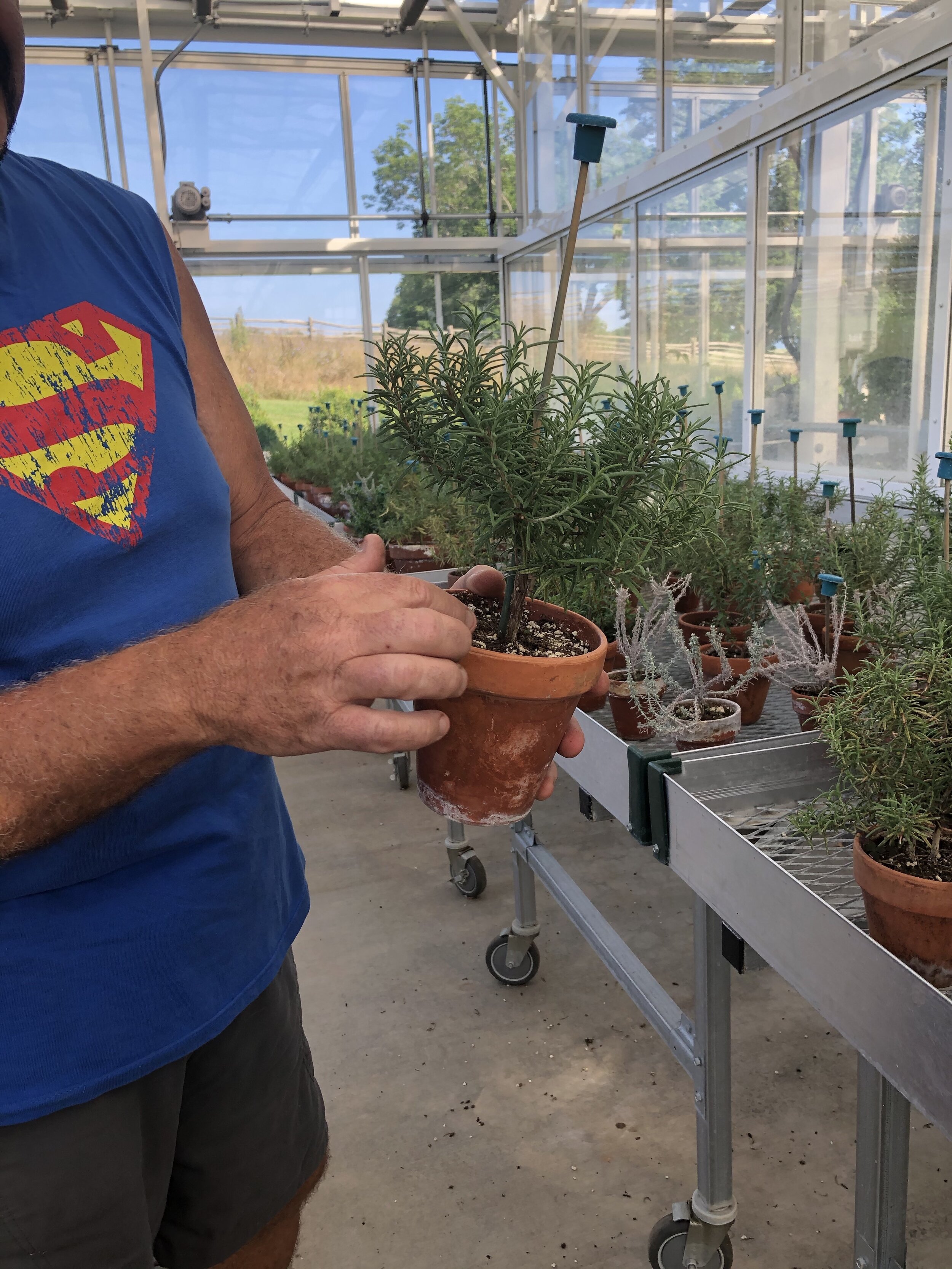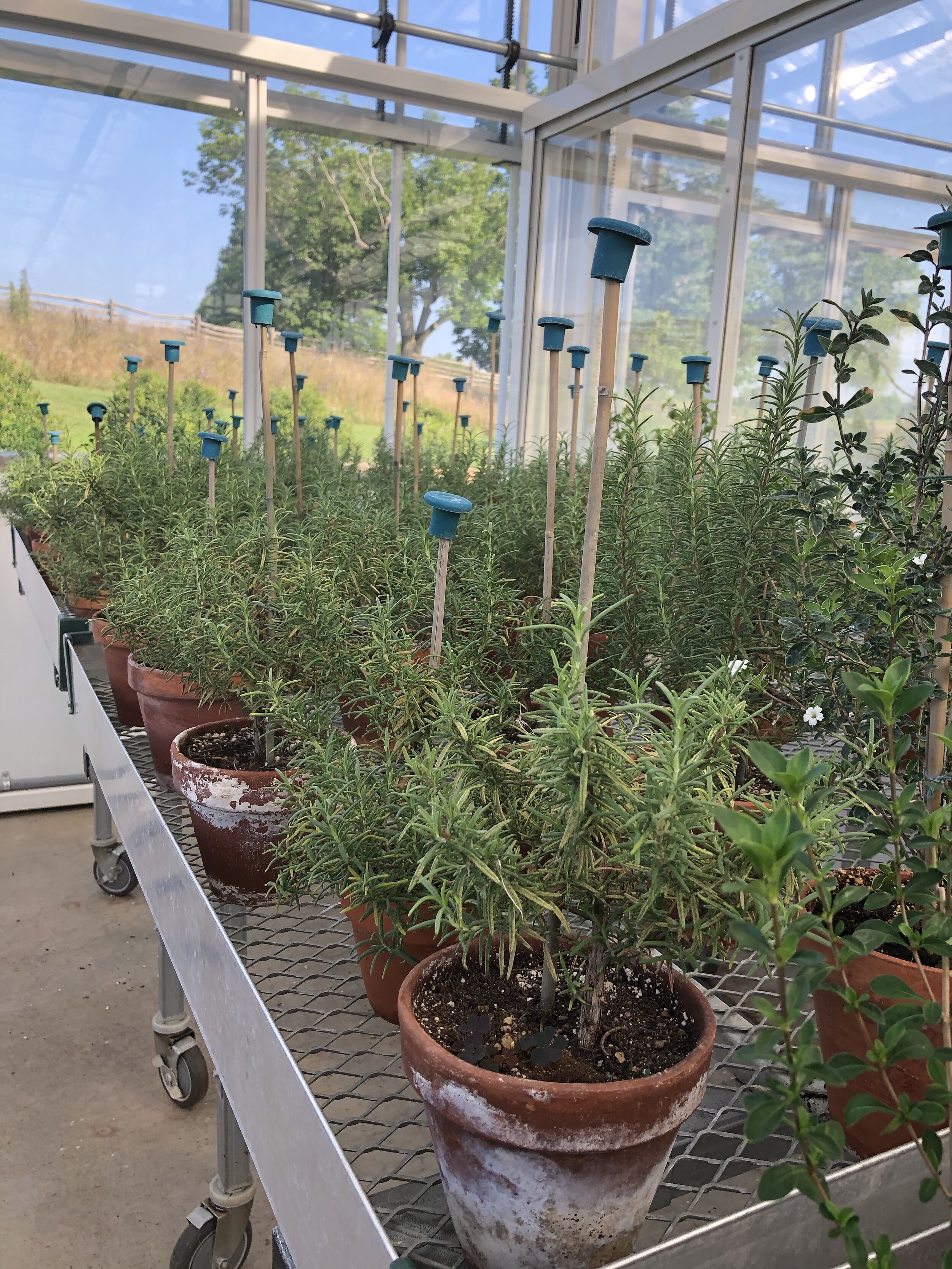How to Start an Herb Tree
Emily Ellis
The pandemic has left many of us with extra time on our hands - and what better way to fill it than with a new horticulture project?
Oak Spring gardener Todd Lloyd with two fully grown herb trees, both around 10 years old.
OSGF founder Bunny Mellon’s creation of her signature miniature topiaries, which she called herb trees, was also the result of a period of boredom and restlessness. She first began sculpting myrtle, rosemary, thyme, and other plants into lollipop-shaped topiaries while convalescing from a pulmonary illness as a young woman, and quickly grew fond of the small, attractive plants. Her gardeners would go on to keep herb trees in regular production over the decades, which she used as decoration in her various homes and as gifts for friends and family. Her fondness for the little topiaries led others to adopt the idea, and today they can be found online and in many florists’ shops.
“They’re just charming,” said Oak Spring Head Gardener Judy Zatsick. The careful curation of the herb trees, as well as other sculpted and espaliered plants around the property, likely appealed to Mrs. Mellon’s artistic side, she said. “She used plants to create living works of art.”
The benefit of the herb trees - which are very similar to bonsais, said Judy, in that they are a larger plant you are training to live in a smaller container - is that you don’t need a lot of space to practice such meditative, creative pruning and plant care. The tiny “trees” are a perfect project for apartment dwellers, as they can do well on a sunny balcony or even a south-facing window.
While fully-grown miniature topiaries can come with a steep price tag, starting your own is relatively inexpensive and simple: all you need are some foam root cubes, root tone, clippers, cuttings from your plant of choice, bamboo stakes, and several small clay pots.
But the most important thing to have before embarking on your herb tree adventure? A lot of patience, said OSGF Gardener Todd Lloyd.
A curry herb tree at about a year old. Because Mrs. Mellon was fond of the plant’s silvery coloring, Todd always keeps plenty of curry herb trees in production for decorative use in the Main Residence and other buildings on the property.
“From the very beginning to the (final) point, you’re talking several hundred hours,” he said.
Todd’s work at Oak Spring includes overseeing the site’s cut flower garden and production greenhouse, where he currently has around 200 topiaries in various stages of life to care for. All of Oak Spring’s herb trees were produced from cuttings from Mrs. Mellon’s original trees. Todd keeps several 50-60 year old topiaries on hand for this purpose, even though they tend to lose their form and color at such an advanced age.
Prior to joining the Oak Spring Garden Foundation, Todd worked for the Mellons for over thirty years, and learned a thing or two about the finicky herb trees during that time.
“It just depends on what you’re going for - if you want them to look nice, you’ve got to spend the time with them,” he said.
At the Oak Spring Garden Foundation, our production of the herb trees is for decorative purposes, as well as to continue practicing the unique horticulture art form beloved by our founder and to pass on that knowledge to new gardeners. The plants Todd primarily uses to make the topiaries include myrtle, rosemary, curry, teucrium, serissa, euonymus, and thyme - all woody perennials that are able to hold up to sculpture.
Todd recommends that beginners to topiaries use rosemary, since it tends to be fairly hardy, grows more quickly than some of the other plants that Oak Spring uses for herb trees, and is less likely to attract insect pests (as an added bonus, it also smells fantastic!)
Starting your Herb Tree
Watch the video below for Todd’s demonstration of how to start and begin pruning a young herb tree, and scroll down for the written instructions. Remember, while starting topiaries from cuttings is relatively simple, it will likely take several years of training and care before they are able to take on a “tree” shape - the steps outlined below are only the first few in a long, but fun and rewarding, process!
Root cubes with cuttings. The curry cuttings (background) are several weeks old; the myrtle and rosemary cuttings in the foreground were recently placed.
Soak your root cubes (Todd uses the Oasis brand) for 24 hours in water until they have absorbed all the water but are not dripping. Cut about 2” of new growth from your plant of choice (again, we recommend rosemary for beginners). Strip the bottom leaves from the cutting, dip the end in water, and then dip it very lightly in root tone (a plant growth hormone) if you choose; Todd uses the Miracle-Gro brand. Set the cutting in the hole in the center of the root cube. Especially if you are new to topiaries or bonsais, you can expect some trial and error along the line, so make more than one cutting!
A root system just beginning on a curry cutting. The bottom must be completely covered in roots (which usually happens at around the four week mark) before you plant it in a pot.
2. Place the root cubes on a plate or tray in a sunny spot (outdoors is fine, unless the temperature it is below freezing) and keep them damp, but not soaking wet. It will likely be a month or more before the bottom of the cube is covered in hair-like roots. You can also trim away excess foam from the root cube so that it will fit more easily into your pot.
A euonymus plant grown from a root cube at about a year and a half old, still in its original pot.
3. Choose a well-draining clay pot with a bottom that is slightly bigger around than your root cube, and place the entire cube in the pot. Cover with your potting mix of choice; Todd recommends mixing in a little sand to help with drainage. If you use a fertilizer, use a very weak one, as you want your plant to stay small. In hot weather, Todd waters the topiaries about twice a day, and about every other day when it is cooler out.
A rosemary topiary at around a year old, which Todd has begun training with a bamboo stake.
4. After about 8-12 months your budding topiary will be large enough to begin training. Tie the main stem of the plant to a bamboo stake with garden twine in order to keep it growing straight; this will be the “trunk” of your herb tree.
Rosemary topiaries-in-training, at around a year old. Todd has begun to take the lower branches off the main stem, and cut away new growth from the upper part of the plant.
5. After you tie your herb tree to a stake, you can begin the pruning process - just be careful not to try and hack your plant into a lollipop shape all at once!
Todd begins pruning by taking off the growth at the very bottom of the main stem, and lightly cutting new growth off of the upper part of the plant. He continues to gradually ease the plant into a tree shape by continuing to taking off new growth, which will be a lighter green that the rest of the plant, as it appears. Typically, about two new growths will appear where each cut has been made. Beginners should be prepared to experiment a little with how much they take off, and how often they prune (this is why starting multiple herb trees is a good idea!)
A rosemary topiary at around 5 years old. Herb topiaries will typically have a lifespan of around 10 years.
It will likely take two more years of careful and gradual pruning before your topiary tree takes on a true lollipop shape, so prepare for an exercise in patience (and if you began your foray in topiaries as a pandemic hobby, cross your fingers that it will be long over by the time you have a fully grown herb tree!)
Of course, if you are using an herb like rosemary or thyme for your topiary, your cuttings can be used in a lot of delicious recipes during the long wait.
If you have any questions for Todd about starting topiaries, or caring for them once they reach a larger size, feel free to reach out through our contact form, and we will pass them on to him!
Additional sources: Tongiorgi Tomasi, Lucia and Willis, Tony. Paul and Bunny Mellon: Visual Biographies. The Oak Spring Garden Foundation, 2020.
Banner image by Roger Foley









